Many believe that leadership growth is not something that can be quantifiably measured. Leadership experts regularly expound on how well their leadership development training works without any proof to substantiate their claims. When asked about how they know it works, the answers typically fall into 2 categories, “We can tell” or the dreaded, “We believe it worked.” Neither of these are acceptable to an organization or an individual that has spent their time and money for the training. With the right tool, a well-designed leadership development training program can easily be quantifiably measured.
“If you can’t measure it, you can’t improve it.”
– Peter Drucker
I have spent most of my career analyzing, predicting, researching and teaching consumer/human behavior for some of the leading companies in the country. So, when I turned my attention to improving leadership 7 years ago, a colleague challenged me to determine how to quantifiably measure leadership improvement to help companies calculate a return on investment on their leadership development programs. I gladly accepted the challenge.
“If you don’t measure leadership, you can’t improve it.”
– J. Bryan Bennett
Leadership is primarily a behavior issue. Better leaders get better results because they can effectively direct and inspire their people to perform their best. Measuring leadership growth not only requires leadership development expertise, but also requires experience in the use and implementation of other disciplines, specifically human behavior, market research and data analysis.

Human behavior is the potential and expressed capacity (mentally, physically, and socially) of human individuals or groups to respond to internal and external stimuli throughout their life. It is the psychology behind motivations and actions. It is needed to help determine what to measure in leadership development. I have over 20 years of experience analyzing and predicting behavior for Fortune 500 client’s customer relationship marketing initiatives as well as several years of teaching customer behavior courses at a leading university.
Research methods are the activity of gathering information about a subject’s needs and preferences. It is used to craft a well-design research instrument with easily understood and meaningful questions. I have been teaching marketing, marketing research and integrated marketing courses at several universities for the last 16 years. I have also had a whitepaper on customer-centric marketing published in an international business journal.
Data analytics is the practice of deriving useful information from data to form actionable insights. The data must be summarized and presented to clearly communicate the most important variations and conclusions. It is needed to analyze and create impactful visualizations of the results. My extensive work in data analytics is world renowned and has been recognized by Gartner. I am the architect of Microsoft’s first global analytics department. I also have 14 years of experience teaching analytics and analytics visualizations at a leading university.
Utilizing these disciplines, the Elite Leadership Academy developed the Leadership IMPACT Assessment (LIA) to better quantify and monitor the results of leadership improvement training undertaken by individuals, groups and/or organizations. The LIA was developed from the key concepts from the books, The Path to Elite Level Leadership (PTELL) and Prescribing Leadership in Healthcare (PLIH). It is completed through the use of a survey to measure 9-dimensions of leadership, which are:
- Humility
- Empathy
- Vision
- Risk-Taking
- Assessing
- Visioning
- Living
- Reflecting
- Coaching
These dimensions are summarized into 2 categories, the Potential for leadership (numbers 1 through 4) and the Practice of leadership (numbers 5 through 9).
Potential for Leadership
Leadership potential is determined by the innate leadership qualities of humility, empathy, vision and risk-taking a person possesses which provides them with a higher leadership ceiling. These are qualities that have proven to produce the best leaders. Some of this can be improved with training, but a solid floor must exist for the leader to reach their full potential.
Potential leadership improves through increased awareness of the innate leadership qualities and the individual embracing them in their daily practice of leadership.
Practice of Leadership
With an established floor and ceiling, the Leader needs to practice their leadership by following a leadership process every day. Leadership improvement only occurs when the learn, practice and review process is utilized. It will not occur using the “one and done” approach of most leadership training programs where an individual takes a course and goes back to work without a personal leadership strategy or follow up coaching.
Leadership practice improves through an elevated focus on the daily practice of leadership.
Contextualizing Results
The results of the LIA provide the individual and/or organization with a snapshot of the person’s leadership behaviors at the time of the assessment. Results require context to be the most illuminating, therefore, to provide immediate context to the leader’s behaviors, their score is compared to the population average of all participants who have taken the assessment. These individuals have taken the LIA through one of our leadership programs, as part of a conference proceeding or individually online. The population average includes results from C-Level executives to managers.
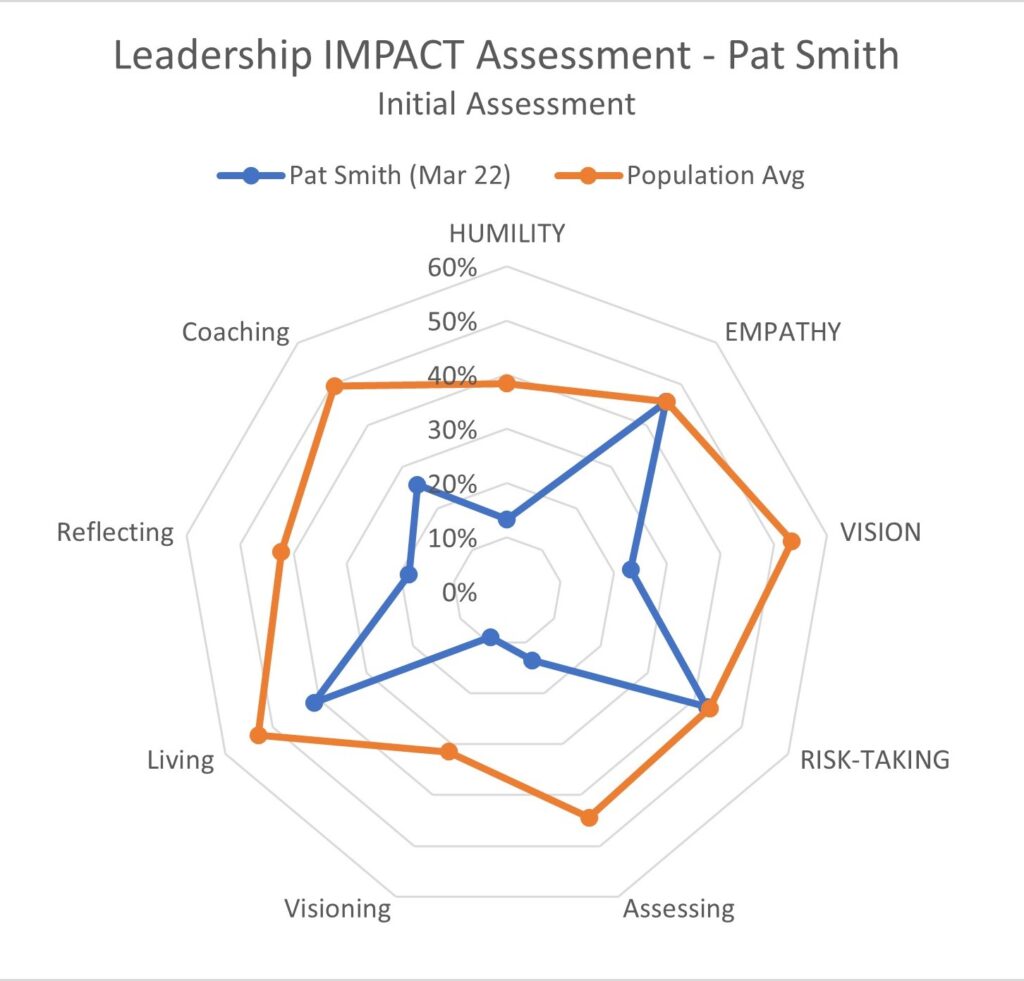
The results are visualized in a radar chart Potential for Leadership dimensions in all caps. The blue line represents the dimension score percentile for the individual who took the assessment and the orange line represents the dimension score percentile for the population average.
For this individual, they are below the population average on all nine dimensions. These leaders are not embracing or even knowing their innate qualities that will define their leadership potential. They are also not practicing any form of leadership process.
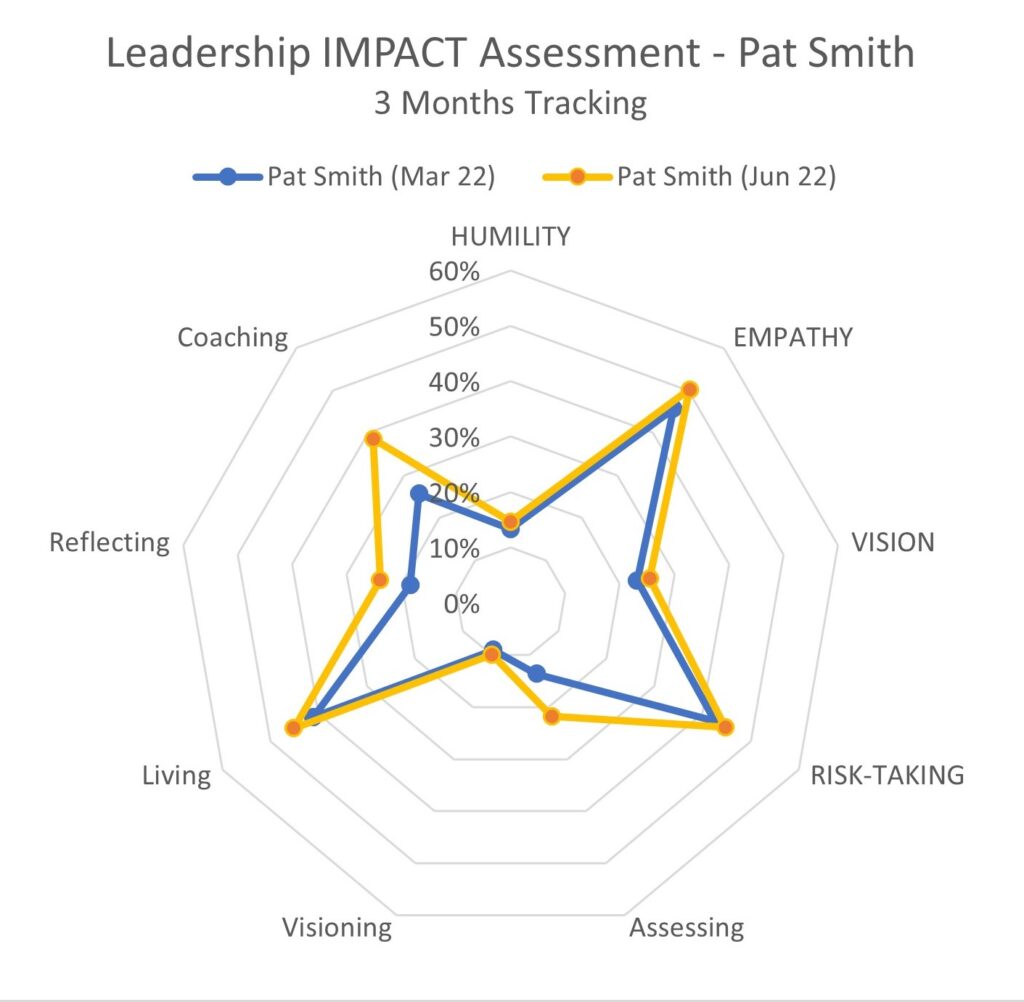
Monitoring Leadership Growth
Leadership growth is monitored as individuals establish a benchmark against the population average and retake it at regular intervals. We typically recommend monitoring 3, 6 and 12 months after the initial assessment.
In this example, after 3 months, the individual has shown improvement in all 9 dimensions with significant improvement in the Assessing, Reflecting and Coaching dimensions. This level of leadership growth is consistent with our findings in a case study.
Assessment Tool Applications
This tool in now available to individuals outside of one of our leadership programs. Individuals and organizations can use it to compare their results to the overall population average or to their internally defined organization population.
When licensed by organizations for internal use, they have several additional benefits, including:
- comparing individual results to the overall population average;
- comparing individual results to an organization’s internal averages when used as a group measurement tool;
- comparing individual results to position level, i.e., C-Level, VP, Director, etc. average using internal or external peer results;
- identifying high leadership potential individuals within the organization.
Most importantly, it can used to identify areas for improvement for any experienced or aspiring leader. Everyone has room for improvement. The challenge is identifying the areas and implementing measures to improve.
It is also the engine that drives our Leadership RMSTM platform.
Conclusion
Using multiple disciplines, an effective tool can be developed that will assess and monitor leadership improvement over time. By comparing individual results to a population average, participants can also determine how they compare to other leaders as an individual or to internal or external peers for group or organizational uses. With quantifiable results, an organization or individual can show a return on their leadership program investment and thus be more accountable. The LIA has been effective in discovering weaknesses in aspiring as well as senior leaders. The next step is to plot and execute a course for improvement. The LIA has been implemented, tested and validated. The LIA has been validated in a recent case study.
Home / Shop
002 - Leadership IMPACT Assessment


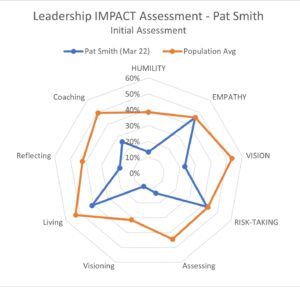
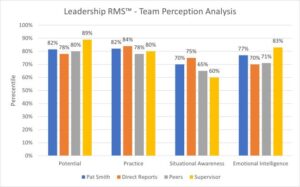
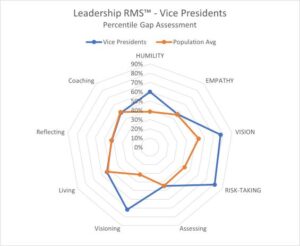





- Description
- Customer Reviews (0)
The Leadership IMPACT Assessment (LIA) is the instrument we use to measure and monitor leadership progress. It was developed from the key concepts from the books, The Path to Elite Level Leadership (PTELL) and Prescribing Leadership in Healthcare (PLIH). The assessment measures leadership behavior along 9 dimensions summarized into two categories: the Potential for Leadership and the Practice of Leadership. It can be used independently to support any leadership development program, as part of our Elite Leadership Training or as the engine that drives our Leadership RMS™ platform.
 When used independently or in conjunction with one of our Elite Leadership Training programs, it assesses an individual’s leadership behavior and identifies gaps compared to the population average. Participants are measured before the course with follow up assessments at set intervals after the conclusion of the course. By quantifying the improvement results, it also helps organizations measure the return on investment of leadership development programs.
When used independently or in conjunction with one of our Elite Leadership Training programs, it assesses an individual’s leadership behavior and identifies gaps compared to the population average. Participants are measured before the course with follow up assessments at set intervals after the conclusion of the course. By quantifying the improvement results, it also helps organizations measure the return on investment of leadership development programs.
When used as part of our Leadership RMS™ solution, it identifies the gaps between how the individual perceives their leadership behavior and how their team, peers and supervisor perceive their leadership behavior. As an organizational assessment tool, it is used to identify gaps between an individual’s leadership behavior and the leadership behavior of their peers throughout the organization. If you any interested in receiving more information or pricing for our Team Leadership RMS™ or Organization Leadership RMS™ solutions, complete the information request form and we will contact shortly.
After completing the assessment you will be sent instructions on scheduling your results debriefing / coaching session. Your results will be sent to you 1 business day before your scheduled session.



